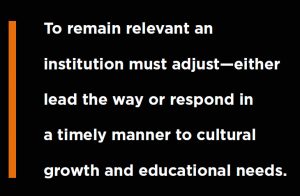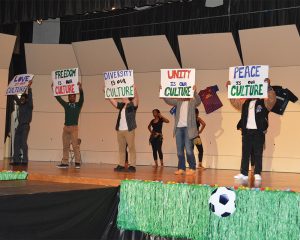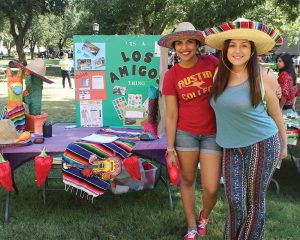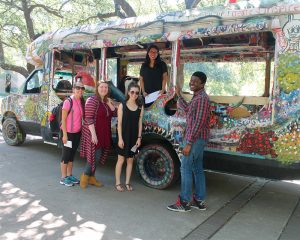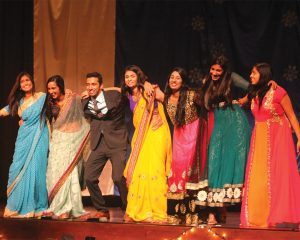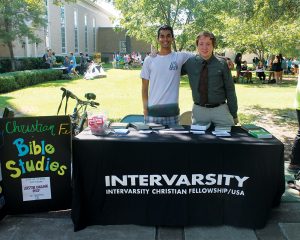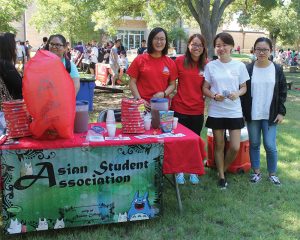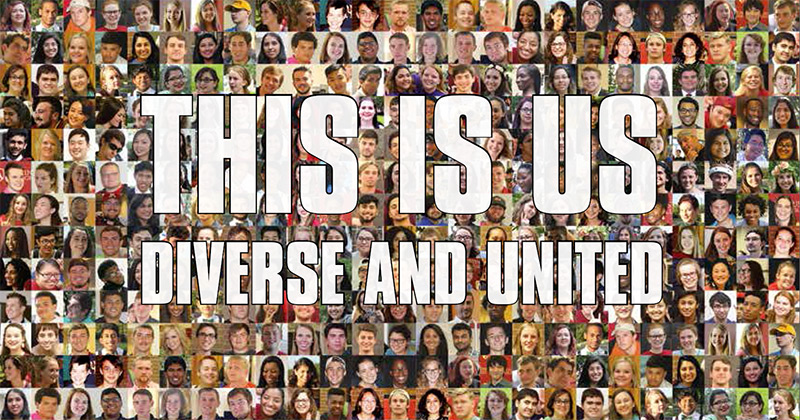
 n any sunny afternoon in Fall Term 2016, some of the 365 members of Austin College’s Class of 2020 pass through campus along Windsor Mall, the branches over the tree-lined walkway creating a shady archway overhead. The scene offers a picture-perfect view of today’s campus while the melodious strains of the carillon from Wynne Chapel add atmosphere to the moment.
n any sunny afternoon in Fall Term 2016, some of the 365 members of Austin College’s Class of 2020 pass through campus along Windsor Mall, the branches over the tree-lined walkway creating a shady archway overhead. The scene offers a picture-perfect view of today’s campus while the melodious strains of the carillon from Wynne Chapel add atmosphere to the moment.
When the 60-some members of the Class of 1956 arrived on campus, College Street ran through campus where Windsor Mall is today, and cars drove by the Administration Building and Student Union Building, right on past Hughey Gym. No Wynne Chapel or carillon bells existed.
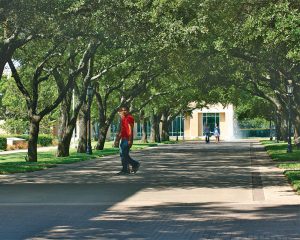 President Marjorie Hass frequently tells alumni that though campus buildings come and go, students and faculty graduate and retire, and courses change, the foundational liberal arts education that makes the Austin College experience transformational for its students remains. The College continues to educate students with a focus on academic excellence, intellectual and personal integrity, and participation in community life that emphasizes respect for all its members.
President Marjorie Hass frequently tells alumni that though campus buildings come and go, students and faculty graduate and retire, and courses change, the foundational liberal arts education that makes the Austin College experience transformational for its students remains. The College continues to educate students with a focus on academic excellence, intellectual and personal integrity, and participation in community life that emphasizes respect for all its members.
To remain relevant an institution must adjust—either lead the way or respond in a timely manner to cultural growth and educational needs. Austin College welcomed women into the student body two years before they won the Constitutional right to vote. In 1942, when the country needed trained military, Austin College taught more than 300 men and women in engineering, science, and management courses sponsored by the United States Office of Education.
During the presidency of Dr. John D. Moseley (1953 – 1978), the campus evolved into the modern age of diversity and saw the beginning of educational practices still used today. Just four decades later, Austin College has its first woman president. The student body and faculty, too, continue to evolve.
Today’s Austin College
A look at today’s student body offers a vibrant picture of people from 30 different citizenships, many religions, or no religion at all. Students identify as liberal, conservative, and wondering. They work hard in areas of study ranging from accounting to Western intellectual tradition. Students come from rural communities and metropolitan cities, graduating from homeschools, private schools, and public schools. They excel in academics, co-curricular activities, and athletics. They’ve served their communities and their places of worship.
Today’s students also represent greater ethnic diversity than ever before, as well as a new high in first-generation college students. In fact, the Class of 2020 is the first minority majority class in the history of the College. Fifty-three percent of freshmen identify as non-white, which brings the minority group percentage of the entire student body to 48 percent. That’s a demographic President Hass is proud to announce.
“Those diversity numbers matter not for the sake of a ‘favorable’ statistic,” Dr. Hass said. “We want a diverse student body because the world in which we live is diverse—and diversity of perspectives expands the experience of all. Our faculty racial diversity also is increasing—from 8 percent in 2010 to 16 percent in 2016. We all have much to learn from one another, whether about life in a country halfway around the globe or the culture of the neighbor down the street. The diversity of our community allows easy dialogue and identity with individuals from a variety of backgrounds and experiences.”
Dr. Hass welcomes the discourse. “We continue to welcome talented students no matter their race, ethnicity, sexual orientation, economic circumstance, religion, or country of birth,” she said. “All students are welcome and should feel they are the center of their college experience and not on the periphery—not because we believe this is politically correct or religiously mandated, but because we cannot fulfill our mission any other way.”
Earlier in 2016, Dr. Hass created the Task Force on Inclusion and Diversity to develop recommendations for best practices for underserved and minority groups in all areas of the College. Dr. Hass says she wants all members of the community to feel valued—not just to the point of acceptance or comfort, though that is important, but valued for their contributions.
Austin College chaplain Dr. John Williams ’84 and psychology professor Dr. Lisa M. Brown serve as co-directors of the task force. Together they lead a team that looks holistically at how Austin College supports diversity and how it serves the educational mission, which includes teaching students to think critically and clearly, understand and respect differences, and express themselves persuasively.
“I definitely had not been in such a diverse place before I came to Austin College,” Yasmin Renteria ’19 said, “so my freshman year was really an eye-opening experience.” She is the president of Los Amigos, a student group organized to bring people together to learn about and celebrate Hispanic culture. Most members are Hispanic students although all are welcome, and many students of other backgrounds join because of an interest in the culture and language. Membership has increased this year, likely a reflection of a greater number of Hispanics in the student body overall. The campus organization list includes several cultural groups, all intent on enjoying their own traditions and sharing them with others who are interested.
Sharing and hearing first-hand knowledge of various cultures and religions enhances the discussion-based classes that are common in a liberal arts education. “In the classroom the professors are open to students’ insight,” said Nikhal Jaisanghani ’17, who is president of the Hindu Student Association and the Indian Cultural Association. “For instance, I took a gnostics class with Peter Anderson (associate professor of English). Much of what we studied had connection with my own religion, and I was encouraged to share. Professors help us develop a confidence to share from our own experience.”
Sharing perspectives is not an occasional opportunity. “There’s a lot of liberty to connect with like-minded peers to talk about issues that matter to them,” Jaisanghani continued.
While the College’s connection with the Presbyterian Church (USA) remains strong and the majority of the student body identifies as Christian, the Religious Life Program cultivates an inclusive atmosphere that supports students’ faith journeys regardless of religious tradition. “We’re not diverse in spite of being a Presbyterian college,” Williams said. “We’re diverse because we’re a Presbyterian college.” The campus community includes opportunities for Buddhist, Hindu, Muslim, Jewish, Catholic, and Protestant students who want to grow in their religious tradition. All groups have open-membership policies so students can learn about one another’s beliefs and views. Inter-faith dialogues are encouraged and supported.
“As a cultural group, Muslim Students Association (MSA) adds a valuable voice about Islam and raising awareness of how Islam really is,” said Rija Soofi ’18, president of the group. “MSA stretches far beyond simply an ‘organization.’ This is a community where Muslims who are away from home can feel comfortable growing and practicing Islam.”
Student organizations dedicated to the celebration and sharing of ideas—Los Amigos (Hispanic culture), Gender-Sexuality Alliance, Indian Cultural Association, Student International Organization, Black Expressions, and Asian Student Association as examples—provide campus events that are attended by broad cross-sections of the campus community.
New Dynamics
President Hass and the Board of Trustees have committed to making an Austin College education accessible to talented students from a wide range of economic backgrounds through merit-based scholarships. Evidence of academic excellence and potential to succeed are the key decision-making factors in granting admission.
In 2016, some 35 percent of students came from households with an Adjusted Gross Income of less than $50,000, and the percentage of students eligible for PELL grants, representing high financial need, has grown from 22 percent to 29 percent over the past five years. That creates another set of issues.
“New dynamics lead to new conversations. And, those bring new problems,” said Dr. Lisa M. Brown, professor of psychology. “The socioeconomic change in the student body brings a set of issues I’ve never seen before. When a student suggests dropping a class because he can’t afford the book, it’s time to consider socioeconomics in our planning. And, it’s time to find an extra book. Also, the fact that his first solution was to drop the class shows we have work to do.”
First-generation college students (the first in their family to attend college) may experience a steep learning curve that begins with understanding the jargon, requirements, and logistics of higher education. And, they face these and other challenges while making all the usual adjustments to the responsibilities and freedoms of campus life, like living with a roommate, learning to manage time, and being away from family.
Many Austin College athletes happen to be the first generation of their families to attend college. “If we’re doing the work of Austin College and building trust through recruiting then I already have a good sense of a student’s background,” said Michelle Filander, head women’s basketball coach. “I use sports language because that’s a language with which they’re quite proficient. When they want the ball they go after it, and go after it, and go after it. If they lose it, they go after it again. I tell my athletes to be aggressive in their course work just like on the court. With sporting language, we’re communicating with everyone regardless of their context.”
A System of Support
In the event any student drops the ball, academically speaking, the College has systems in place to identify the trouble spot, make a recovery plan, provide support, and hold the student accountable. “Diversity and differences among students today cause us to provide support and assistance through a network of individuals outside of the classroom,” Tim Millerick, Austin College vice president for Student Affairs, said. “We offer coaching and tutoring through academics, assistance with transitions, and fundamentally work to ensure that each of the different student populations has the timely and accurate information they need to be successful in their Austin College experience.”
Millerick refers to staff such as those in the Academic Skills Center, which offers assistance with college coursework, study habits, content-specific peer tutoring, and accommodations for documented learning disabilities. The center also includes a staff member providing support services for transfer students and international students as both have their own set of issues in settling into the campus community. Student Engagement, Enrichment, and Development (SEED) staff also help students with adjustment to college life, as do professionals in Career Services, Residence Life, Health Services, and Counseling Services—all working together to offer a broader, deeper network of support at Austin College than ever before. And, of course, faculty provide assistance beyond the classroom as mentors and guides for their students, working with Student Affairs staff as needed when issues are identified.
Sabrina Yassin ’20 left her home in Addis Ababa, the capital city of Ethiopia, and traveled 8,300 miles for a better education and safety from civil unrest in her country. “The country is at civil war and the government will not allow us to go to college in Ethiopia until things ‘settle down,’” Sabrina said. “In college the students tend to protest, and then the government sends soldiers … so I am better off here.”
She readily admits she misses her parents and nine younger siblings. Her father wanted this opportunity for her, and initially her mother objected—but came around. “She’s a mom, you know,” Yassin said. “After my parents left me here, it was hard.” Her pre-med studies are challenging, partly because she did not have the high school science lab facilities that are common in the U.S. She has adjusted her coursework, and takes care of herself with attending a stress management group on campus.
Academic, social, and emotional health all are part of each student’s picture of success. “As with all of higher education, we’ve seen an increase of students with learning differences that result in the need for particular accommodations, such as alternative test-taking environments and time adjustments with tasks,” Millerick said. “Our student body also reflects a greater population coming here having already received support on a range of counseling issues and emotional needs. We’re poised to take care of them because they are our kids.”
Chaplain Williams echoed Millerick’s commitment: “Our goal is to understand how to ask the right questions that will benefit everyone as we accompany students in their journey at Austin College. We are diverse, but rather than imposed diversity, I would say our diversity is organic—it’s the result of caring for the people who are here.”
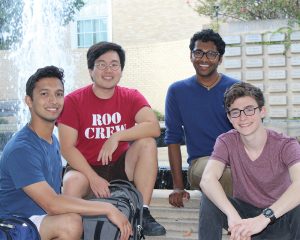
Photo by Vickie S. Kirby
Four Roommates—Four Religions
A beautiful thing about diversity is that it’s often simply dressed as friendship. Ganesh Maniam ’17 who is Hindu, found himself paired with Noah Selz ’17, who is Jewish, as freshman roommates. They were a great match, and when they wanted to move to different housing the next year, they needed two more roommates—enter Rohail Rahman ’17, a Muslim, and Jason Shin ’17, a Christian. Of course, the roommates didn’t even recognize the “diversity” of their living situation. Chaplain John Williams ’84 pointed that out later. The roommates simply are friends, and none is superconscious of their “differences.”
They consider their diversity phenomenon a coincidence born out of friendship.
Ganesh said he was impressed that the refrigerator was always full because it takes a lot of groceries to accommodate the various diets … beef, no beef, pork, no pork, and traditional Korean, Indian, Pakistani, and Jewish dishes. Plus snacks. That’s a lot of groceries.
The roommates have attended social events at one another’s supporting organizations. The Hindu goes to the Jewish Rosh Hashanah celebration. The Christian goes to Diwali with the Hindu. They simply enjoy the opportunities to experience new things with good friends.
Welcomed and Supported
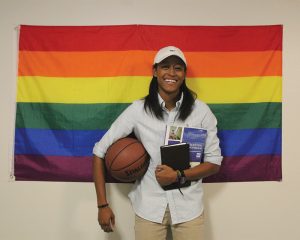
Photo by Priya Chary
Before junior Morgan Laday ever committed to Austin College as a basketball player and pre-med student, she got assurance from a campus tour guide that she would be accepted for herself. She’s an athlete who grew up playing softball, golf, basketball, soccer, tennis, and track. She’s African-American, a serious student, a Christian, and gay.
“My Admission tour guide was gay, and I asked him how accepting it was here, if being gay was okay,” Morgan said. “One of the reasons I chose this school is the welcoming atmosphere.”
Morgan has a busy agenda with studies and involvement with Black Expressions, Gender-Sexuality Alliance, and the basketball team. “Study for classes already takes up a lot of time,” she said. “Before basketball season I was really involved with Black Expressions. We put on several events and talk a lot about the current issues in society—not just issues that affect African-Americans but those that affect a variety of minorities.”
“I’ve never felt discriminated against because I’m gay,” she said. “It might sound cheesy, but I know the whole school has my back.” Morgan received the Austin College LGBT Alumni Scholarship, which was created by the alumni group to benefit students who exhibit exemplary academic achievement, high standards of personal character, commitment to the LGBT community, and financial need.
“I know I always have people in my corner no matter what race, religion, or sexual identity I am,” Morgan said. “And, having a community that supports LGBT people is a huge thing sometimes. Not everyone is as fortunate, but I am lucky enough to have a family that loves me no matter who I love.”
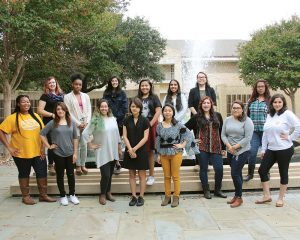
Photo by Erin E. Laine
The Sorority of the Plaid Skirts
The self-named Sorority of the Plaid Skirts is a coalition of students attending Austin College through a relationship with the Young Women’s Preparatory Network (YWPN). Greyka Galvan ’17, the group’s campus leader, will graduate this spring with a degree in business administration.
Eight high schools around the state participate in the network and agree on the mission of single-gender, college-preparatory, public education that equips young women with academic and leadership skills to succeed in college and life.
“I would say my all-girl, magnet high school education made all the difference in the world for me,” Greyka said. “Our priorities weren’t boys, but scholarships, connections, and college acceptances. We were taught to advocate for ourselves and our worth in such a way that we were made leaders. My Dallas high school, Irma Rangel, had the motto: ‘Girls today, women tomorrow, leaders forever.’ These words are strong. They hold meaning. It gave us and still gives us a drive to excel, even now that we are in college.”
The group’s members range from freshmen to seniors and study a variety of academic disciplines. They support one another with social events and one-on-one communications. “There are many personalities and characters among our sisters but we all get along really well,” Greyka said. “We text each other whenever we need anything or want advice. I feel like it really helps the girls’ transition from high school to college, knowing that when they get here, they’re not alone.”
Austin College is in its third year of formal partnership with YWPN and meets the full demonstrated financial need of three to five freshman students each academic year and through their next three years. Admission staff members have worked closely with the schools for many years. Currently 18 alumni of YWPN schools attend Austin College.
Michal Magdziak—Tackling Texas
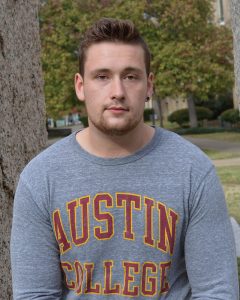
Photo by Erin E. Laine
From Michal Magdziak’s ’20 home in Warsaw, Poland, you can drive three hours north to the Baltic Sea or three hours south to the Carpathian Mountains. The drive is a lot longer in North Texas to get that kind of variety. Although he may miss the scenery of his homeland, Michal chose Austin College and Texas for specific reasons.
“I applied to other universities in the United States, but I chose Austin College because I wanted to play football and the school is academically demanding. Also, it’s situated in Texas for hot weather and where football is a serious thing,” he said. Believing that a U.S. education will help him in the future, he also came here to improve his English and have better employment opportunities.
“I haven’t decided my major yet, but it’s probably going to be math or business,” he said. Reading long academic assignments in English language has been challenging, and he is designing his course load to be successful.
Along with learning English, Michal has discovered a few things about himself since coming to Austin College. “I’m not well-organized,” he said, “but it is not hard for me to find new friends.”
Football has helped with both of those things, since the team provides an instant peer group. “I think football helped me get used to college due to not having a lot of free time. This forces me to become a better-organized person. I’m working on it.”
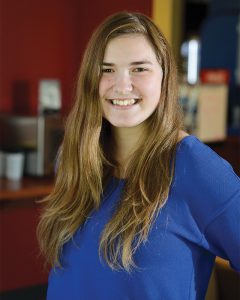
Austin College Photo
Diversity is the Norm
As a freshman, Erin Laine focused on academics early in fall 2015, as most freshmen are advised to do. But for a person who is better when busy, it’s hard to hold back for long.
“I ran for freshman representative in Student Assembly, which began in the spring for me last year, and then I got very busy,” Erin said. She shrugs off the idea of being “too busy,” saying she’s had a job since she was 11 years old, first at a miniature horse farm, then as a tutor. She also led a Houston-area 4-H chapter as president for four years.
Erin was homeschooled and took many of her classes at a community college. “I’ve always been an independent learner, and I understand how to manage time pretty well,” she added. Growing up in the large, international city of Houston, she has been exposed to the variety and benefits of diverse people and opportunities.
“I love diversity and have had a diverse group of friends,” she said. “It’s important to look beyond culture because we are all diverse. We come from different socioeconomic backgrounds and different places. Having all these perspectives at Austin College is important to a full experience.”
This year, Erin brings her unique perspective to daily life as a resident advisor, campus tour guide, student letter writer for the Admission Office, and campus event photographer. She also serves on the Food Advisory Committee for Student Assembly. Erin is in the Austin Teacher Program, majoring in English with a minor in education.

